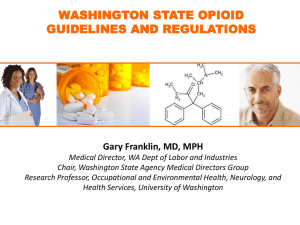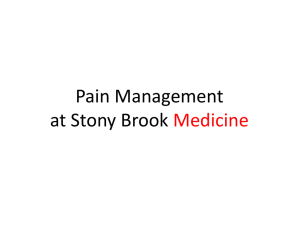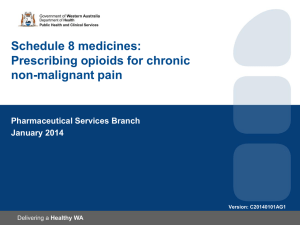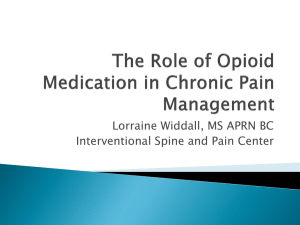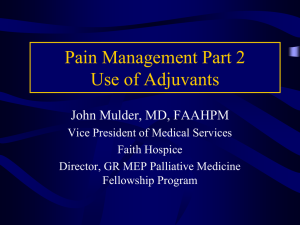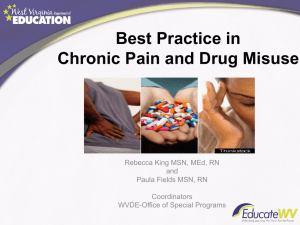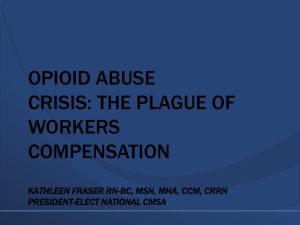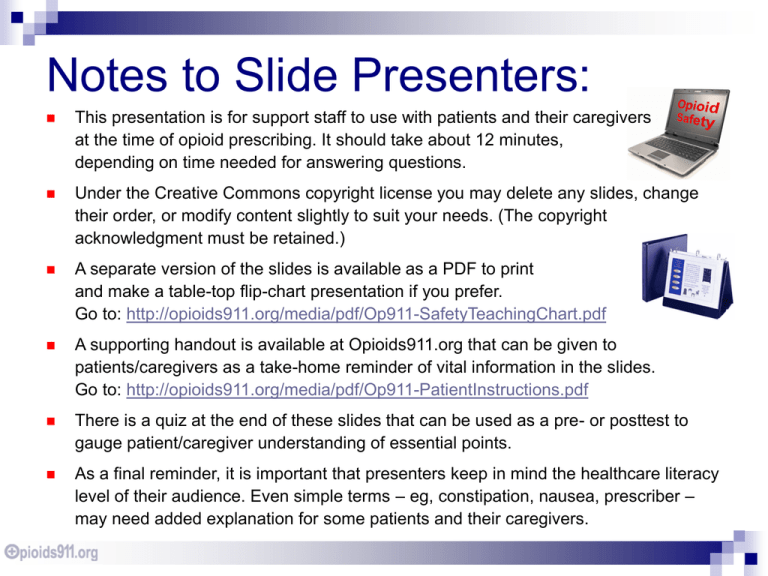
Notes to Slide Presenters:
This presentation is for support staff to use with patients and their caregivers
at the time of opioid prescribing. It should take about 12 minutes,
depending on time needed for answering questions.
Under the Creative Commons copyright license you may delete any slides, change
their order, or modify content slightly to suit your needs. (The copyright
acknowledgment must be retained.)
A separate version of the slides is available as a PDF to print
and make a table-top flip-chart presentation if you prefer.
Go to: http://opioids911.org/media/pdf/Op911-SafetyTeachingChart.pdf
A supporting handout is available at Opioids911.org that can be given to
patients/caregivers as a take-home reminder of vital information in the slides.
Go to: http://opioids911.org/media/pdf/Op911-PatientInstructions.pdf
There is a quiz at the end of these slides that can be used as a pre- or posttest to
gauge patient/caregiver understanding of essential points.
As a final reminder, it is important that presenters keep in mind the healthcare literacy
level of their audience. Even simple terms – eg, constipation, nausea, prescriber –
may need added explanation for some patients and their caregivers.
Acknowledgments
This component of Opioids911-Safety was independently developed
with funding support provided in part by…
A sponsorship from King Pharmaceuticals® Inc.
An educational grant from Purdue Pharma L.P.
Publication Date
First publication September 2010
Researcher/Writer
Stewart B. Leavitt, MA, PhD
Medical Reviewers
Edward Hesterlee, BS, PharmD, FACA; Seth I. Kaufman, MD;
Lee A. Kral, PharmD, BCPS; James D. Toombs, MD;
Winnie Dawson, MA, RN, BSN.
Research Sources
Reference citations for resources used in developing Opioids911.org
are available at: http://opioids911.org/researchsources.php
E-mail questions or comments to: Admin@Opioids911.org
How to Safely
Use Opioid
Pain Relievers
©Copyright 2010, Opioids911-Safety from Pain Treatment Topics. Use for patient education is authorized
under a Creative Commons Attribution-NonCommercial 3.0 Unported License. All rights reserved.
Opioid Safety Needs YOU!
Always follow these important Safety Tips…
Never take an opioid pain reliever unless it is
prescribed for you.
Take opioids only as directed. Do not take more
opioid or take it more often than is prescribed.
Do not use opioids with alcohol or any other drugs
unless approved by your opioid prescriber.
Protect and lock up your opioids in a safe place at all times, and
properly dispose of any leftover medicine.
Never share opioids with another person, it is illegal and dangerous.
Be prepared for opioid emergencies. Know signs of trouble and
what to do in an emergency.
Read instructions that come with your opioid prescription. Contact
your prescriber or pharmacist with any questions.
Many Types of Opioids Are Available
Opioids are for moderate to severe pain. Some, like codeine and
morphine, are made from the opium poppy plant. Others are made
from chemicals but have pain-relieving actions similar to opium.
Opioids can be short-acting or long-acting…
Short-Acting Opioids – generally relieve pain for about
4 hours and are prescribed to be taken every 3-4 hours.
Examples: codeine, hydrocodone, hydromorphone, morphine,
oxycodone, oxymorphone, propoxyphene, tapentadol, tramadol; and
fast-acting fentanyl tablets, film, or lozenges.
Long-Acting Opioids – are taken from 1 to 4 times per day as pills
or applied as a patch that lasts several days or much longer.
Examples: methadone; long-acting formulations of hydromorphone,
morphine, oxycodone, oxymorphone, tramadol; and patch formulations
of buprenorphine and fentanyl.
Even though opioids* have
been safely used to treat
pain for thousands of years,
they also can be very dangerous
medicines. People sometimes
misuse, abuse, or overdose on
opioids and it can be fatal!
*Opioid medicines are sometimes wrongly called by the
older term, “narcotics.”
Opioid Overmedication Signs
Intoxicated behavior – confusion, slurred speech,
stumbling or trouble balancing.
Feeling dizzy or faint.
Feeling or acting drowsy, or nodding off to sleep.
Unusual snoring, gasping, or snorting during sleep.
Difficulty waking-up from sleep and becoming alert or
staying awake.
Call your Opioid Prescriber.
U.S. residents also can call the National Poison
Hotline at 1-800-222-1222.
Do NOT just go to sleep – you may not wake up!
Opioid Overdose Emergency
Person cannot be aroused or wakened, or is
unable to talk if awakened.
Any trouble breathing – such as being short of
breath, slow or shallow breathing, or stopped breathing.
Gurgling noises coming from mouth or throat.
Body is limp, seems lifeless. Face is pale, clammy.
Fingernails or lips turned blue/purple.
Slow or unusual heartbeat or stopped heartbeat.
Call emergency medical services right away!
If a child or pet ever swallows an opioid that was
not prescribed for them, it is always an emergency.
Caregivers should know rescue procedures, like CPR.
Opioid Overmedication or
Overdose Can Happen From…
Taking too much opioid medicine or taking it
too often.
Drinking any alcohol (beer, wine, or
hard liquor) while taking opioids.
Taking opioids with ‘street drugs.’
Someone else, like a family member or child
(or a pet), swallowing your opioid medicine.
Opioid Overmedication or Overdose
Also Can Happen When…
First starting opioids or increasing the dose.
Changing to a new opioid.
Starting other medicines that may increase
the amount opioid in the body (called a
“drug interaction”).
Always watch for signs of overmedication or overdose
– if in doubt, call for help.
It can take some time, even days, for overmedication or
overdose to appear.
Taking Opioids Safely…
Never chew, cut, crush, or dissolve opioid
tablets, or open opioid capsules, unless you
are specifically instructed to do so.
Opioid patches must never be cut or folded, and they
need to stick to the skin completely.
Always remove the old patch before putting on a new one,
unless instructed otherwise.
Never expose patches to heat from hot baths or saunas, heat
lamps or pads, electric blankets, or other heat sources.
If you are prescribed an opioid liquid, ask the pharmacist
for a device to accurately measure each dose.
Do not drive or operate machinery until you know how
opioids will affect you.
Opioids Can Have Side Effects…
The most common are:
Constipation due to opioids may not go away, so you
should ask your opioid prescriber about how to treat it.
Nausea may last several days, and there is medicine
that can help with this.
Sedation — feeling mildly tired or groggy — may last a few
days after starting opioids or when the dose is increased.
Less common:
Itching, dry skin, confusion, muscle twitching, dry mouth,
sweating, fatigue, weakness, mild headaches – all are usually
temporary. Addiction and allergy to opioids are rare.
At any time, difficulty breathing or staying awake could be
signs of serious trouble – call for help.
Preventing Opioid Problems
Read all instructions that come with your
opioid prescription.
Only one healthcare provider should
prescribe opioid pain relievers for you.
Have all medicine prescriptions filled at
the same pharmacy.
Always take opioids exactly as prescribed and
avoid alcohol and street drugs.
Inform all healthcare providers of all medicines you use.
Involve your caregivers so they can help look after you.
Take good care of your opioid medicine – ruined, lost, or
stolen opioids might not be replaced until time for a refill.
Safeguard Your Opioids
Never store opioids in a bathroom or kitchen
cabinet or on a countertop.
Best – keep your opioids in a locked drawer,
cabinet, or lockbox at all times.
Never share your opioids with anyone else
– it is against the law & may harm them.
Flush away leftover opioids in the toilet, never
keep unused opioids in your home.
Note: other medicines are not disposed of this way.
Ask your opioid prescriber or pharmacist about disposal.
Remember: persons you least suspect may be looking
for opioids to steal for their own use or to sell.
Opioid Dependence – is Not Addiction
Opioids naturally may cause physical dependence
(tolerance & withdrawal)…
Tolerance – your body becomes used to the opioids
and they may not offer the same amount of pain relief.
Withdrawal – you may feel ill if the opioids are suddenly
decreased or stopped.
This is not addiction, which is using opioids for their
mood-altering effects and being unable to stop using them.
Persons who use opioids only as instructed by their
healthcare providers for pain rarely become addicted.
To treat your pain effectively, your opioid prescriber must
know if you, or a blood relative, has had problems with
substance abuse or addiction in the past.
Opioid Withdrawal – Signs/Symptoms
Withdrawal may occur if you suddenly reduce the opioid dose or stop
taking opioid medicines, or if there is a drug interaction.
Muscle and joint aches.
Stomach cramps.
Rapid breathing.
Racing heartbeat.
Repeated yawning.
Runny nose and eyes.
Enlarged (dilated) pupils.
Drooling.
Goose bumps.
Trouble sleeping.
Irritable, restless.
Diarrhea.
Vomiting.
Tremors or shakes.
Heavy sweating.
Loss of appetite.
Craving for opioid.
Confusion.
Chills.
Hot flashes.
Opioid withdrawal is much like a bad case of the flu. Everyone does not experience
all of the effects, at all times, or to the same extent. Withdrawal can be prevented,
or treated if it does occur. Talk to your opioid prescriber or pharmacist.
Visit Opioids911.org for more information.
Remember…
Never take an opioid pain reliever unless it is prescribed
for you.
Always take opioids as directed. Do not take more
or take it more often than is prescribed.
Do not use opioids with alcohol or other drugs or medicines
unless your opioid prescriber approves.
Protect and lock up your opioids in a safe place, and properly
dispose of leftover medicine.
Never share opioids with another person, it is illegal and
dangerous.
Be prepared for opioid emergencies. Know signs of trouble
and what to do.
Contact your opioid prescriber with any questions.
©Copyright 2010, Opioids911-Safety from Pain Treatment Topics. Use for patient education is authorized
under a Creative Commons Attribution-NonCommercial 3.0 Unported License. All rights reserved.
How Much Do You Know About
Opioid Safety?
1. Where should opioids always be stored?
a) In a convenient place, like a cabinet or countertop.
b) In an out-of-the-way place and locked up is best.
c) Neither of the above.
2. When is it okay to share your opioids with another person?
a) If they need it to relieve pain.
b) If they have their own prescription for the same opioid.
c) It is never okay to share opioid medicine and is against the law.
3. What should be done with leftover opioid medicine?
a) Flush it down the toilet.
b) Save it in case you need it again.
c) Throw it in the trash.
4. Which of the following suggest that a person may be overmedicated with opioids?
a) Itchy eyes and runny nose.
b) Muscle or joint aches and pains.
c) Confusion, slurred speech, acting mildly intoxicated.
How Much Do You Know? (continued)
5. What should be done if opioid overmedication is suspected?
a) Take a nap to sleep off the effects.
b) Call the opioid prescriber or National Poison Hotline for advice.
c) Skip the next scheduled dose of opioid medicine.
6. Which of the following are signs of opioid overdose?
a) Trouble breathing or unable to wake up from sleep.
b) Feeling nervous and depressed.
c) Neither of the above.
7. If opioid overdose is suspected, what should be done?
a) The person should be put in a cold shower or bath.
b) Make the person comfortable and let them sleep it off.
c) Call emergency services immediately.
8. Which of the following may bring about opioid overmedication or overdose?
a) Increasing the opioid dose or starting a new opioid medicine.
b) Starting other medicines while taking opioid pain relievers.
c) Both of the above.
9. What are the 3 most common opioid side effects?
a) Constipation, nausea, and sedation.
b) Enlarged or dilated pupils in the eyes, runny nose, dry skin.
c) Loss of appetite, stomach cramps, hot flashes.
How Much Do You Know? (continued)
10. Which of the following is true about addiction?
a) It is easy to become addicted to opioid medicines.
b) Needing a higher opioid dose to relieve pain is a sign of addiction.
c) Neither of the above.
11. What should be done if a child or pet swallows your opioid medicine?
a) Watch them closely for awhile to see how they react.
b) Call for help immediately.
c) Splash them with cold water to keep them awake.
12. Which statement is true?
a) Opioid pain relievers should be prescribed by only one healthcare provider.
b) Opioid prescriptions should always be filled at the same pharmacy.
c) Both of the above.
13. Can alcohol be used while taking opioid pain relievers?
a) An occasional beer or glass of wine is okay.
b) It can be dangerous to mix any alcohol with opioids.
c) Only if the alcohol is taken between opioid doses.
14. Is it safe to drive a car while taking opioid medicines?
a) Not until opioid affects are known and the prescriber says it is okay.
b) Yes, as long as the opioids are not mixed with alcohol.
c) Driving during the day is okay but not at night.
How Much Do You Know? – Answer Key
Correct Answers Are…
1b, 2c, 3a, 4c, 5b, 6a, 7c, 8c, 9a, 10c, 11b, 12c, 13b, 14a
Note to Healthcare Provider:
Other than having face validity to assess a general understanding of key points presented in the
various questions, this quiz has not been otherwise field-tested to determine clinical validity or
reliability in different populations of patients. No assurances can be made that a high performance
on the quiz will result in desired behaviors regarding opioid safety.


